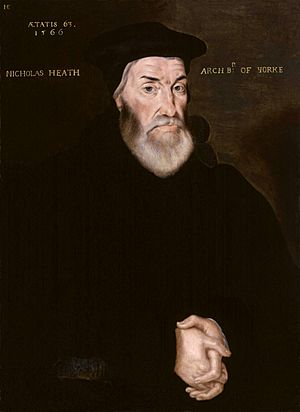Nicholas Heath facts for kids
Quick facts for kids The Most Reverend Nicholas Heath |
|
|---|---|
| Archbishop of York | |

Portrait by Hans Eworth
|
|
| Church | Roman Catholic |
| Enthroned | 1555 |
| Reign ended | 1559 |
| Predecessor | Robert Holgate |
| Successor | Thomas Young |
| Orders | |
| Consecration | 4 April 1540 by Stephen Gardiner |
| Personal details | |
| Born | c. 1501 London, England |
| Died | 1578 (aged 76–77) Chobham, Surrey |
| Buried | Chobham, Surrey |
Nicholas Heath (born around 1501, died 1578) was an important religious leader in England. He was the very last Roman Catholic Archbishop of York. He also served as the Lord Chancellor, a top government official. Before that, he was the Bishop of Worcester.
Contents
Early Life and Education
Nicholas Heath was born in London, England, around the year 1501. He went to Oxford University and then Cambridge University. He studied hard and became a fellow at Christ's College, Cambridge. Later, he became an Archdeacon of Stafford in 1534.
Heath traveled to Germany with Edward Foxe, who was the Bishop of Hereford. Their goal was to find common ground with the Lutheran princes there. This trip showed that Heath was open to some changes in the church. However, his later life showed he remained loyal to the Roman Catholic Church.
A Time of Change
In 1539, Heath became the Bishop of Rochester. In 1543, he became the Bishop of Worcester. Heath was a Catholic, but he was not as strict as some other leaders of his time. He believed it was important for England to be united in its faith.
He seemed to accept some of the early changes made by King Edward VI. He even accepted the first Book of Common Prayer. This book had been changed to be more Catholic-friendly.
Challenges and Restoration
Heath disagreed with the English Reformation over a new church service book called the 1550 ordinal. He refused to accept it. Because of this, he was put in prison and lost his bishopric in 1551.
When Queen Mary I became queen, Heath was set free. He got his bishopric back and was made president of the Council of Wales and the Marches. In 1555, he became the Archbishop of York. He did a lot to improve the church in York. He even built York House in London.
After another important leader, Stephen Gardiner, died, Heath became Lord Chancellor. He was chosen for this role partly because he, like Cardinal Pole, did not like the Spanish influence in England. Heath was also against the harsh punishments used during Mary's reign. No Protestants were burned in his area. However, he did not have much power over the queen's decisions.
Loyalty to the Queen
When Queen Mary died, Heath, as Lord Chancellor, quickly announced that Elizabeth I was the new queen. He believed that Parliament had the right to decide who would be the next ruler.
Elizabeth did not keep him as Lord Chancellor. However, he stayed on her private council for two months. He even helped arrange a meeting in 1559 to try and find common ground between Catholics and the new Elizabethan church.
Heath refused to crown Elizabeth as queen. This was because she would not allow a certain part of the coronation service to happen. He believed that church ceremonies and beliefs could not be changed by national leaders.
Later Life
Heath strongly opposed Elizabeth's new laws about the church. He had accepted earlier changes under Henry VIII and Edward VI. But he now believed that Sir Thomas More had been right about the Pope's authority.
Because of his beliefs, he lost his position as Archbishop in 1559. However, he remained loyal to Queen Elizabeth. After a short time in prison, he was allowed to live peacefully for the next 19 years. He did not attend public church services but sometimes had Catholic Mass in private.
Queen Elizabeth visited him more than once at his home in Chobham, Surrey. He died there at the end of 1578 and was buried there.

